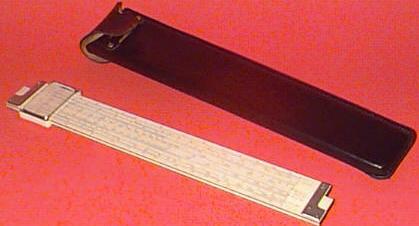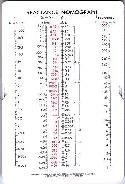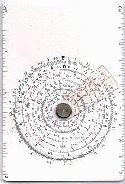HEMMI     |
Many brands are really an illusion of distribution, and the sea of makers and model numbers often leads back to a very few actual slide rule manufacturers. Possibly the most widely re-distributed slide rules, were those actually made by Hemmi's Bamboo Slide Rule Company Ltd. in Japan.
These rules exist under Hemmi's own trade name "SUN", and then re-appear as some of the industry's most well known names, such as POST, Hughes-Owens, Odelco, Geotec, and others in other countries, such as the Netherlands. Faber-Castell also made rules for other makers, especially Dietzgen, and it is interesting to compare the different incarnations of these rules between Europe and the USA. |
 K+E had a strange habit of re-numbering slide rules from time to time, so that there are many virtually identical K+E rules, marked with very different K+E numbers. In addition, K+E also had many mechanical/scale variations, often quite significant, of specific rules like the 4081, yet continued to mark them with the same part number, thus truly baffling collectors for years afterwards. K+E had a strange habit of re-numbering slide rules from time to time, so that there are many virtually identical K+E rules, marked with very different K+E numbers. In addition, K+E also had many mechanical/scale variations, often quite significant, of specific rules like the 4081, yet continued to mark them with the same part number, thus truly baffling collectors for years afterwards.
 The biggest numbering change was the shift from 4xxx numbers to 68-1xxx numbers, in which older rules received shiny new numbers, and certainly the most puzzling "non-change" involves the very popular Duplex Deci-Trig Log Log 4081-3 slide rule. The biggest numbering change was the shift from 4xxx numbers to 68-1xxx numbers, in which older rules received shiny new numbers, and certainly the most puzzling "non-change" involves the very popular Duplex Deci-Trig Log Log 4081-3 slide rule.

 This rule appears as a laminated rule with revealed wood edges, and as a fully laminated rule with covered edges, as well as with every possible kind of K+E case (black hardboard, black leather, green leather, orange leather), numerous slightly different scale sets, and at least three different kinds of cursor. Then it suddenly gets converted to a 68-1210 in the new scheme of things. The 4081 also gets converted to a solid "Ivorite" plastic body, appears briefly under the odd name "DORIC" (with NO part number, then suddenly as a 9081, then an N9081-3), then surfaces again as the 4181. By this point, I'm dizzy. K+E even packed notes in boxes advising users that the instruction books (for the 4081) were also for the "new" 4181, and many K+E boxes come labeled with "was this, is now this" legends, adding to the high chaos level for collectors trying to figure out what the rule really is. Sigh. This rule appears as a laminated rule with revealed wood edges, and as a fully laminated rule with covered edges, as well as with every possible kind of K+E case (black hardboard, black leather, green leather, orange leather), numerous slightly different scale sets, and at least three different kinds of cursor. Then it suddenly gets converted to a 68-1210 in the new scheme of things. The 4081 also gets converted to a solid "Ivorite" plastic body, appears briefly under the odd name "DORIC" (with NO part number, then suddenly as a 9081, then an N9081-3), then surfaces again as the 4181. By this point, I'm dizzy. K+E even packed notes in boxes advising users that the instruction books (for the 4081) were also for the "new" 4181, and many K+E boxes come labeled with "was this, is now this" legends, adding to the high chaos level for collectors trying to figure out what the rule really is. Sigh.
 Hemmi rules were marked with their SUN logo/trademark in most parts of the world, but not in North America. It is not so clear why Hemmi chose to sell virtually all it's products via re-branding in North America, but the reasons seem to be related to strong anti-Japanese feeling after World War 2, and (an incorrect) feeling that Japanese products were of inferior quality, both of which would have been difficult to overcome in the 1950's and 1960's. Many older examples of Hemmi rules imported to the USA are found with the "made in Japan" sanded off by owners for this very reason. The most popular rule among collectors (voted recently by web survey repondents) was the POST versalog, a rule actually made by Hemmi, their original number 258. POST branded rules always still carried the Hemmi Japan information on them. Hemmi rules were marked with their SUN logo/trademark in most parts of the world, but not in North America. It is not so clear why Hemmi chose to sell virtually all it's products via re-branding in North America, but the reasons seem to be related to strong anti-Japanese feeling after World War 2, and (an incorrect) feeling that Japanese products were of inferior quality, both of which would have been difficult to overcome in the 1950's and 1960's. Many older examples of Hemmi rules imported to the USA are found with the "made in Japan" sanded off by owners for this very reason. The most popular rule among collectors (voted recently by web survey repondents) was the POST versalog, a rule actually made by Hemmi, their original number 258. POST branded rules always still carried the Hemmi Japan information on them.
   CONCISE and Sama & Etani CONCISE and Sama & Etani
Concise circular rules were often sold in the USA with Company logos and markings, as promotional items. This sometimes confuses neophyte collectors into thinking they have found a unique rule, when it is merely a house-marked Concise brand slide rule made for advertising reasons, that says 3M, Garrett, So-and-so Heating, etc... Many of these circular slide rules with special data charts and metric conversion data were designed and marketed by Sama & Etani in North America, but manufactured by Concise in Japan, further confusing matters as to the real origin of the slide rule. Mr. Sama and Mr. Etani dreamed up the idea of the data chart rules, and metric factors designs as part of their business school thesis, speculating they might be able to sell 30,000 pieces. They wound up selling more than a million units, and their logo-marked rules were incredibly popular and widely used in many industries as promotional items.
They designed a very interesting circular rule, the Data Center, which was rectangular, had a circular rule on the face, rulers along the sides, conversions to periodic tables on the rear face, and a pull-out double-sided data card that had industry specific information. This rule appears in many variations for many different end customers, but they are all Concise manufactured rules from the same exact place. Concise rules were also re-branded and sold by Fullerton, Lafayette and numerous other companies, in addition to the special designs created by Sama and Etani..
 The Frederick Post Company, and POST slide rules (often actually made by Hemmi except during the second world war), were in turn taken over by Teledyne in the early 70's, with a sudden frenzy of new part numbers like 44DA-410, to replace earlier numbers like the 1441. For a few brief years, these often dual marked rules appeared, and also went through some subtle mechanical changes such as plastic cursors and new scale markings. The most fascinating aspect of the Hemmi-Post relationship was Hughes-Owens, who marketed slide rules (mainly in Canada), and even offered a Versalog rule (no. 1777) and companion Versalog hard cover book. The book is identical to the POST book, but with the substitution of the name Hughes-Owens on the cover. It produces quite a double take the first time you see it. Hughes-Owens eventually became Geotec, confusing the picture a bit more for everybody with yet another set of numbers for the same rules. The Frederick Post Company, and POST slide rules (often actually made by Hemmi except during the second world war), were in turn taken over by Teledyne in the early 70's, with a sudden frenzy of new part numbers like 44DA-410, to replace earlier numbers like the 1441. For a few brief years, these often dual marked rules appeared, and also went through some subtle mechanical changes such as plastic cursors and new scale markings. The most fascinating aspect of the Hemmi-Post relationship was Hughes-Owens, who marketed slide rules (mainly in Canada), and even offered a Versalog rule (no. 1777) and companion Versalog hard cover book. The book is identical to the POST book, but with the substitution of the name Hughes-Owens on the cover. It produces quite a double take the first time you see it. Hughes-Owens eventually became Geotec, confusing the picture a bit more for everybody with yet another set of numbers for the same rules.
|


 Walter Shawlee 2.
Walter Shawlee 2.









